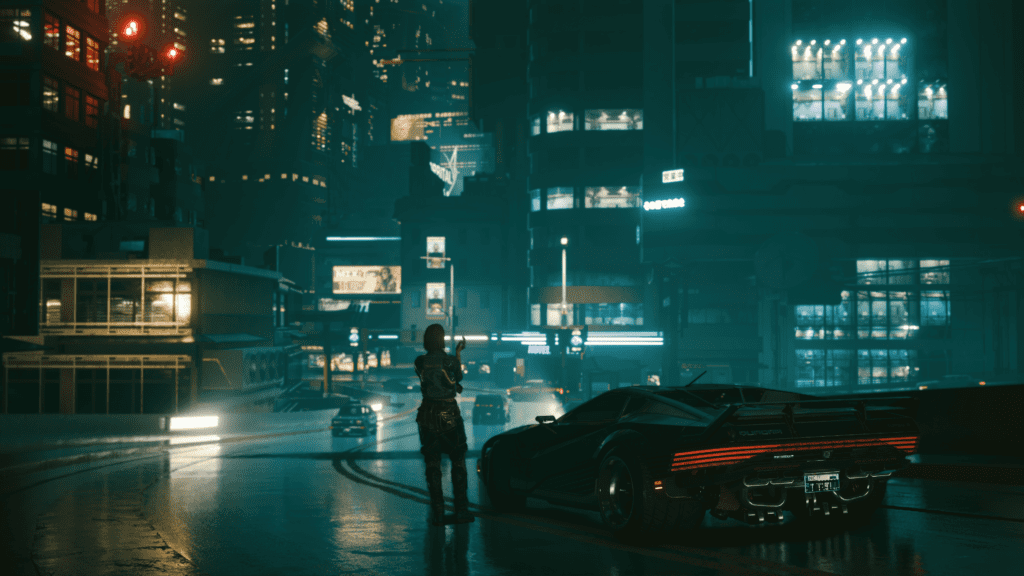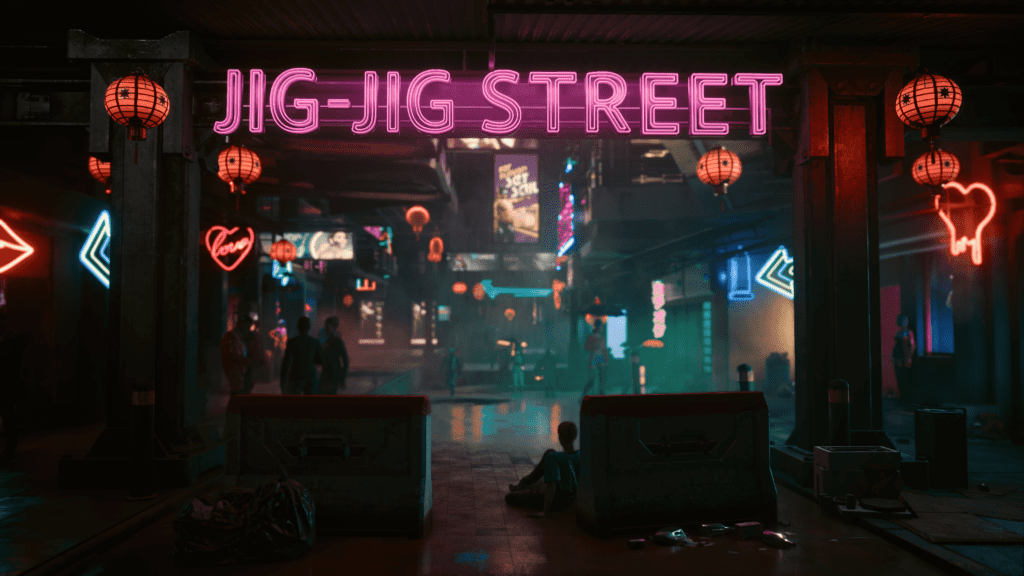Few career criminals who successfully escape Night City tend to harbour any grand aspirations of returning. Hidden in nooks throughout the scrubland that clings to its perimeter are plenty of artefacts indicating failed attempts at securing freedom—smouldering campfires, hollowed out cars, burst luggage receptacles. If it isn’t armed border security or even the conflict-certified AWACS missile systems that eventually pin them down, then a cavalcade of black-on-black Militech trucks often won’t be too far behind either. For the majority of its inhabitants, the Free State of Night City in the New United States of America is a dead end. For many players who expectantly picked up the game upon its release, the reality wasn’t so much different.
My first visit to Night City came to an end mired in just as much turmoil as it had begun. Over the course of 125 hours of play, I had completed every mission, visited every landmark and unlocked every PlayStation trophy. I had also been worn down to an undeniable state of apathy in the time that it took me to reach the safety of the end credits. That prolonged investment of time is all on me, of course. The release build of Cyberpunk 2077 offered so little, yet all that my stubbornness managed to yield was something akin to a sunk cost fallacy. Anxious to experience the depths of the game’s depravity, as well as recoup my losses for hours already spent, disappointment turned to despair which gradually evolved into something closer to morbid curiosity. All it took to reach that point was accepting that my system was going to crash at least twice per session. This version of Night City was shrouded in a permanent shadow, and no matter the strength of its content, its technical fragility ensured that problem after undeniable problem, the delicate layers of immersion that it cultivated would all be peeled back until nothing recognisable remained.
I left Night City with the knowledge that behind every door and underneath every tarpaulin was something horrendously out of place. It truly was the city of the unexpected, and though episodes of spontaneous anarchy would bookend every session, it was in the fleeting moments of peace that Cyberpunk teased its world of grand possibilities. In the pouring rain, beneath a canopy of glass and amidst a sea of flickering neon, CD Projekt RED’s dark future behemoth even almost succeeded in its deception. That is until the cogs started turning again and all of the adjacent parts began to sputter and spark once more. What compelled me to return was to see exactly how much of my original stay in Night City had been tarnished by its technical flaws. And now that the game had been subject to over a year of dedicated repairs, just how much of worth had been salvaged from the wreckage. In late 2022, with a dedicated PlayStation 5 patch having just released and a hefty story-driven expansion announced for the following year, I started afresh on a blank save slot and began my career as a mercenary for a second time. At least knocking back a glass of whiskey as a Street Kid made for a better first impression than vomiting into a sink as a Corpo.
My review of Cyberpunk 2077, first published in February 2021, didn’t exactly skimp on the negatives. There was just so much abhorrently wrong with the game that simply attempting to exist within the confines of Night City tore at the very fabric of its digital boundaries. Predictably, my first steps within the 1.6 framework were as tentative as I could muster. To my surprise, nothing particularly nefarious was waiting for me in ambush. By the time that I had joined in tandem with Keanu Reeves’ character Johnny Silverhand once more, the city that opened up before me was far more stable than I had remembered. Night City had a touch of life about it now. At least it seemed as though enough of the loose hanging threads had been snipped, anyway. Pedestrian behaviour was much improved for one. And a glance from left to right might’ve forcibly spawned a few more cars in both directions, but thankfully it didn’t eject them into the air from beneath the tarmac. My system wasn’t crashing either. All the while 60 frames-per-second remained largely unbroken, even as the city shrunk in the rear-view mirror and the badlands spread out before me.
Free from facing a new technical issue every few steps, it became a lot easier to see the ways in which my initial play-through of the game had been hampered by both a lack of patience and an active need to push back against dozens of dynamic problems. The reason why I originally settled on such an indirect mode of combat—that being a ranged quick-hack build—was largely because early-game encounters dropped frames faster than I could drop bodies, and any sort of battle practically invited the game to crash on me. This time around, trading in hacking for tenderising allowed me to garner a much greater appreciation for the depth of combat, my augmented fists at the forefront of a destructive build that also managed to wedge in light machine guns and shotguns. When combat in Cyberpunk clicks, it really clicks. Every kill I made increased my speed of movement, which drew me directly into the maw of the enemy. Backing me up were biological gadgets that would send out a local EMP if my health dropped too low, reinvigorate me with a mid-fight blood transfusion, and even resurrect me from the dead via a motorised second heart. It was a messy flow state of guts and gore that I struggled to control, but it was wonderfully thrilling and a tremendous amount of fun. What’s more, being able to engage with conflict in a way that better exemplified the game’s addictive power fantasy made me much more interested in the fate of the user-controlled protagonist, V. With the risk of death ever-present and the reload from last save option just a few errant button presses away, V’s cybernetically-enhanced strength sits much easier alongside her narratively designed fragility. It’s no cure for every touch of ludonarrative dissonance that Cyberpunk and many of its contemporaries are guilty of, but it’s a much more enthralling way to interact with both the story and gameplay from a narrative perspective.
My total time with Cyberpunk 1.6 clocked in at around 25 hours longer than my original run. Certainly, that extra days worth of longevity can be attributed to having much more patience with it this time around. A renewed appreciation for combat made many of the filler activities, like Gig missions, take on a more prominent role when it came to building my character. Knowing that none of my progress was about to disappear on a whim was a luxury last compromised by the Xbox 360 and its red ring of death almost two decades ago. As the time I was investing was now being done so meaningfully, I had plenty more reason to explore some of Night City’s many smaller, hidden stories too. A problem that the vanilla experience suffered with that completely threw me off was when characters would step over their own lines, starting their next sentence before having finished the one prior. With examples of this being massively reduced (though frustratingly, not eradicated entirely) I even began to enjoy some of the story’s longer conversations and the stellar voice work that brought them to life. The stabilisers were well and truly off—no more speed-reading subtitles for this Merc. After enough hours had passed that the problems of before had noticeably receded into the back of my mind, Cyberpunk 2077, that is, the video game rather than the series of warped funhouse mirrors, began to impart a little more of itself hour by hour. In 2023, some 2 years and several months after its initial release, Cyberpunk 2077, the thrilling high-octane RPG and the marquee virtual tourism destination is certainly unworthy no longer.
Its resurgence may have been well earned, but there are still some unshakeable points of contention that look as though they’ll forever live alongside Cyberpunk in infamy. Some are undeniably objective—issues that arose during the games conception that can be attributed to rewrites and repackaging. The consequences of cutting room disasters and developmental crunch periods still ruminate, evident in choppy pacing and often hurried story beats. At times, you can almost see the seams with which two disparate approaches to a single idea have been fastened together. Other examples are a little more difficult to pin down. In its enormity, Night City doesn’t quite delve deep enough into much of the minutiae that orbits its story of digital immortality and the ownership of the self. My favourite side quest in the game teases AI-controlled humans manipulating political figures from beyond the digital veil. It’s rather out there, but it touches upon the intangible horrors of 2077’s dystopia in a different way to that of the Soulkiller narrative. And nothing else quite comes close to matching it. Take a moment to stop and observe, and you’ll catch a glimpse at some of the more intrinsic aspects of Night City: poverty, classism, self-commodification and social disassociation among them. But Cyberpunk 2077, both then and now, just moves too fast to really examine any of these elements at length. Separated from the frenetic pace of the main narrative, the best that Cyberpunk offers is still found in those smaller stories, ones in which humanity stands in defiance of the big, bad city. As it is in 2023, at least Night City is now better equipped to tell them.

